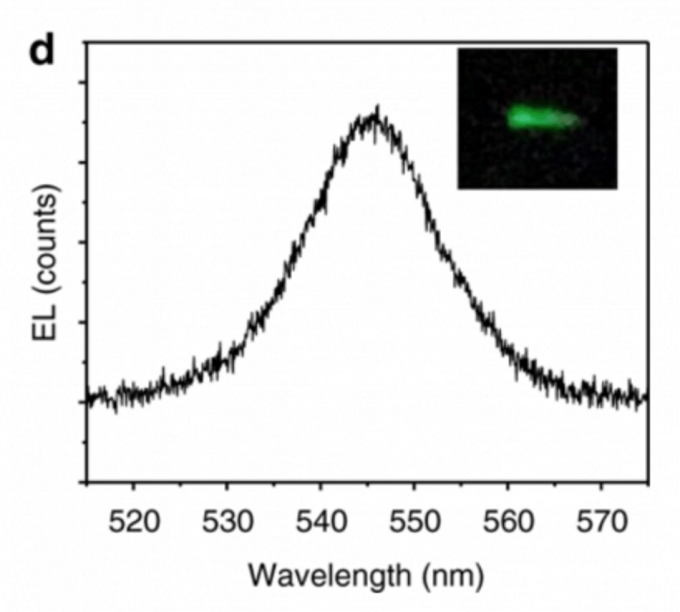Jan 11 2019
In 1839, when Gustav Rose, a German mineralogist, stood on the slopes of the Ural Mountains in Russia and collected a piece of a formerly undiscovered mineral, he had certainly not heard of diodes or transistors or never had an inkling of how traditional electronics would become an essential part of people’s everyday lives.
 These are the wavelengths of light emitted from the spintronic LED. The inset shows the green light from the device. (Image credit: University of Utah)
These are the wavelengths of light emitted from the spintronic LED. The inset shows the green light from the device. (Image credit: University of Utah)
He eventually called the mineral “perovskite”. However, he could not have expected that the rock he held in his hand could one day transform electronics as people know them today.
In 2017, Valy Vardeny, a physicist at the University of Utah, dubbed perovskite a “miracle material” for a growing field of sophisticated electronics, referred to as spintronics, and he still stands by that assertion. Now, in a paper reported in Nature Communications, Vardeny, together with Dali Sun (now at North Carolina State University), Jingying Wang¸ and coworkers, demonstrated a pair of devices designed using perovskite to show the potential of the material in spintronic systems. According to Vardeny, the material’s properties bring the prospects of a spintronic transistor closer than ever.
Spintronics
A traditional digital electronic system transmits a binary signal (think 0s and 1s) through electron pulses carried via a conductive wire. Spintronics has the ability to transmit extra information through another property of electrons, that is, their direction of spin (think up or down). Spin is associated with magnetism. Therefore, magnetism is used by spintronics to either align electrons of a specific spin, or “inject” spin into a system.
If individuals have performed the old science experiment of changing a nail into a magnet by constantly dragging a magnet along its length, then they would have already experimented with spintronics. Information is transferred to the nail by the magnet. The trick involves transporting and making use of that information, which needs materials and devices with finely tuned characteristics. Scientists are striving toward the breakthrough of a spin transistor—a spintronics version of the electronic parts found in almost all the latest electronics. For such a device, a semiconductor material is required in which a magnetic field can effortlessly control the direction of electrons’ spin—a property known as spin-orbit coupling. However, fabricating such kinds of transistors is not easy, Wang stated. “We keep searching for new materials to see if they’re more suitable for this purpose.”
Here is where perovskites come into play.
Perovskites
Perovskites are a group of minerals that are characterized by a specific atomic structure. Their potential as a technological material came to be known only in the past decade. Due to that atomic structure, investigators have been making perovskite into a material to fabricate solar panels. By 2018, they successfully achieved an efficiency of around 23% of solar energy transformed to electrical energy—a major increase from 3.8% in 2009.
Meanwhile, Vardeny, along with his coworkers, was studying the possibilities of spintronics as well as the numerous materials that may prove effective in transmitting spin. Since perovskite contains heavy lead atoms, physicists estimated that the mineral may exhibit robust spin-orbit coupling. In a 2017 study, Vardeny and Sarah Li, a physics assistant professor, demonstrated that large spin-orbit coupling is indeed exhibited by a class of perovskites known as organic-inorganic hybrid perovskites. Moreover, the lifetime of spin injected into the hybrid materials lasted a comparatively long time. Both results indicated that this type of hybrid perovskite shows potential as a spintronics material.
Two spintronic devices
The subsequent step was to integrate hybrid perovskite into spintronic devices. This was accomplished by Wang and Vardeny in their recent work. Spintronic light-emitting diode, or LED, is the first device. Within a conventional LED, the semiconductor contains electrons and holes—which refer to places in atoms where electrons should be but are not. When flowing through the diode, the electrons fill the holes and discharge light.
According to Wang, a spintronic LED operates more or less in the same way—but with a magnetic electrode—and with electron holes polarized to house electrons of a specific spin. Wang added that the LED illuminated with circularly polarized electroluminescence shows that the magnetic electrode effectively transferred spin-polarized electrons inside the material.
It’s not self-evident that if you put a semiconductor and a ferromagnet together you get a spin injection. You have to prove it. And they proved it.
Valy Vardeny, physicist, University of Utah.
A spin valve is the second device. Analogous devices are already available and are applied in devices like computer hard drives. An external magnetic field present in a spin valve flips the polarity of magnetic materials in the valve between a closed, high-resistance state and an open, low-resistance state.
The spin valve of Vardeny and Wang does more. Using hybrid perovskite as the device material, the scientists can inject spin within the device and subsequently cause the spin to wobble or precess inside the device through magnetic manipulation. That, according to the researchers, is a big deal.
“You can develop spintronics that are not only useful for recording information and data storage, but also calculation,” Wang stated. “That was an initial goal for the people who started the field of spintronics, and that’s what we are still working on.”
These experiments, when taken together, demonstrate that perovskite functions as a spintronic semiconductor. The eventual objective of a spin-based transistor is still a number of steps away; however, this analysis lays a key foundation for the path ahead.
“What we’ve done is to prove that what people thought was possible with perovskite actually happens,” Vardeny stated. “That’s a big step.”
The U.S. Department of Energy Office of Science funded the study.